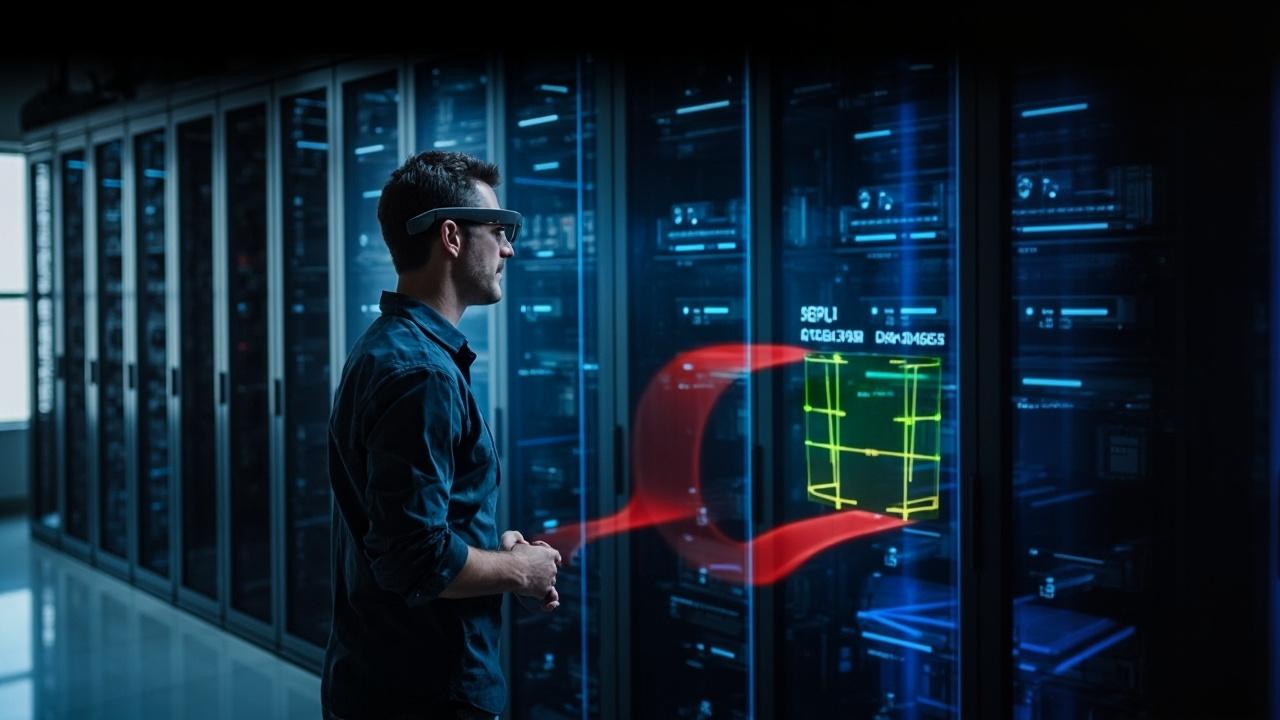Introduction
Is your data center operating at its peak potential? Many data center managers grapple with the daily realities of fragmented information, reacting to crises rather than proactively preventing them, and struggling to optimize resource allocation. The key is dcim integration.
Often, Data Center Infrastructure Management (DCIM) is viewed primarily as a monitoring tool, diligently tracking temperature, power consumption, and other environmental variables. While this monitoring function is undoubtedly valuable, it only scratches the surface of what a robust DCIM solution can truly achieve.
The true power of DCIM lies in its potential to become the central intelligence hub of the entire data center operation. Imagine a system that not only monitors the health of your infrastructure but also orchestrates all functions to achieve optimized performance, significant cost savings, and proactive problem-solving. This vision requires a fundamental shift in how we perceive and implement DCIM – moving beyond simple monitoring to a comprehensive, integrated management approach.
This article will explore how DCIM can evolve into the brains of your data center. By breaking down data silos, fostering seamless communication between systems, and leveraging advanced analytics, DCIM empowers you to transform reactive firefighting into strategic, proactive management. This journey will uncover how to harness the full potential of DCIM to create a more efficient, resilient, and future-proofed data center environment.
The Current State
The modern data center, despite its technological advancements, often resembles a collection of isolated islands. Power management operates independently from cooling, which is separate from asset tracking, security protocols, and network monitoring systems. Each of these domains generates valuable data, but because these systems rarely communicate effectively, the potential insights are lost in translation. This fragmented approach leads to significant operational inefficiencies and hinders the ability to respond swiftly and strategically to evolving demands.
The consequences of these data silos are far-reaching. Delayed response times become commonplace, as operators struggle to piece together information from disparate sources to understand the root cause of an issue. Identifying the source of a server failure, for instance, can involve manually cross-referencing logs from multiple systems to determine if it was a power surge, a cooling malfunction, or a network connectivity problem.
This not only prolongs downtime but also ties up valuable IT resources. The lack of a unified view also leads to duplicated efforts, where different teams independently monitor the same metrics without realizing that another group is already addressing the issue. Reporting becomes a cumbersome and often inaccurate process, relying on manual data collection and consolidation, making it difficult to gain a true picture of data center performance.
Consider the scenario of over-provisioning resources. Without a holistic view of power consumption and server utilization, data center managers often err on the side of caution, allocating more power and cooling capacity than is actually needed. This results in wasted energy, higher operating costs, and underutilized infrastructure.
Similarly, capacity planning becomes a guessing game, as managers lack the comprehensive data needed to accurately predict future resource requirements. This can lead to either over-investment in unnecessary equipment or, conversely, insufficient capacity to meet growing demand, impacting business operations. All of these inefficiencies can be resolved by effective dcim integration.
| Data Silo Problem | Resulting Inefficiency |
|---|---|
| Separate power and cooling management | Over-provisioning of resources, wasted energy |
| Isolated asset tracking and network monitoring | Delayed response times to incidents, extended downtime |
| Disparate reporting systems | Inaccurate performance assessment, poor capacity planning |
DCIM as the Central Nervous System
The limitations of current data center management strategies stem from a fragmented approach. Different teams often manage separate aspects of the infrastructure, leading to poor communication and inefficiencies. Data center teams might be using separate systems for power management, cooling optimization, asset tracking, security monitoring, and network performance analysis.
This siloing of data creates a lack of comprehensive visibility, making it difficult to identify the root cause of problems and respond quickly to critical events. The result is often reactive problem-solving, duplicated efforts, and inaccurate reporting, ultimately hindering the data center’s overall performance and agility.
To overcome these challenges, DCIM must evolve into the central nervous system of the data center. This involves a shift from a purely monitoring-centric view to a holistic perspective where DCIM acts as the central repository and aggregator of data from all corners of the data center ecosystem.
This means collecting real-time data from power distribution units (PDUs), cooling systems, environmental sensors, servers, network devices, and other critical infrastructure components. By consolidating all this information into a single platform, DCIM can provide a unified view of the entire data center environment.
Real-time data visualization and customizable dashboards are crucial for providing this comprehensive operational overview. These tools allow data center managers to quickly assess the health and performance of their infrastructure, identify potential issues, and make informed decisions. By correlating data from different sources, DCIM can reveal hidden relationships and dependencies that would otherwise go unnoticed.
This empowers data center teams to proactively address problems before they impact critical services and optimize resource allocation for maximum efficiency. The need for proper dcim integration with other systems is very important as well.
| Area of Focus | Benefit of Holistic DCIM View |
|---|---|
| Power Management | Real-time power consumption data and identification of overloaded circuits. |
| Cooling Optimization | Identification of thermal hotspots and optimization of cooling setpoints. |
| Asset Tracking | Improved asset inventory management and reduced risk of misplaced equipment. |
Unlocking Proactive Management
With the implementation of a robust DCIM platform, data centers can transition from merely reacting to incidents to proactively preventing them. By leveraging advanced analytics, DCIM can sift through the vast amounts of data generated by the data center, identifying patterns and anomalies that would otherwise go unnoticed. This includes monitoring equipment performance, environmental conditions, and power consumption to predict potential failures, capacity bottlenecks, or thermal anomalies.
For instance, DCIM can analyze historical data to determine when a UPS battery is nearing its end-of-life, allowing for proactive replacement before a power outage occurs. Furthermore, trend analysis of cooling performance can reveal hotspots or inefficiencies, enabling adjustments to airflow or cooling unit settings before they impact critical equipment.

The true power of predictive analytics is realized when combined with automation. DCIM can be configured to automatically respond to predicted events, minimizing downtime and optimizing resource utilization. Imagine a scenario where DCIM predicts a potential capacity constraint based on current workload trends.
The system could automatically trigger the provisioning of additional resources, such as spinning up virtual machines or allocating more storage, before the constraint impacts performance. Similarly, if DCIM detects an impending equipment failure, it can automatically trigger alerts to the appropriate personnel, initiate failover procedures, or even schedule maintenance windows. All this can be done with minimal human intervention, ensuring swift and effective responses to potential problems.
Effective implementation of proactive management requires seamless dcim integration with other systems. For example, integrating DCIM with a building management system (BMS) allows for automated adjustments to cooling based on predictive thermal analysis. Similarly, integrating with an IT service management (ITSM) platform enables automated incident creation and resolution based on predicted equipment failures.
This interconnectedness ensures that the right information is delivered to the right people at the right time, empowering them to make informed decisions and take swift action. The implementation of predictive analytics and automation transforms DCIM from a passive monitoring tool into a proactive management platform, optimizing performance, minimizing downtime, and ensuring the data center’s continued resilience.
DCIM Integration
The true power of a DCIM solution is unleashed when it’s not operating in isolation. Data centers are complex ecosystems, and optimal performance requires seamless communication between various systems. That’s why dcim integration is essential for breaking down silos and creating a unified operational view. By connecting DCIM with other critical platforms, you can unlock a wealth of insights and automate key processes, leading to significant improvements in efficiency and responsiveness.
Consider the benefits of integrating DCIM with your Building Management System (BMS). Instead of separate teams monitoring and managing environmental controls, DCIM can share real-time data on temperature, humidity, and airflow with the BMS. This allows for more intelligent and automated control of cooling systems, preventing hotspots and optimizing energy consumption.
Similarly, integrating DCIM with your IT Service Management (ITSM) platform can streamline incident response. A power outage detected by DCIM can automatically trigger a ticket in ITSM, alerting the appropriate personnel and initiating pre-defined remediation workflows.
Furthermore, integrating DCIM with Configuration Management Databases (CMDBs) ensures that asset information is always up-to-date and accurate. When DCIM detects a new server being installed or an existing one being moved, it can automatically update the CMDB, eliminating manual data entry and reducing the risk of errors.
Even integrating with Enterprise Resource Planning (ERP) systems can provide valuable insights into the financial implications of data center operations, allowing for better budget planning and resource allocation. The key to successful dcim integration lies in adopting an API-driven approach, favoring open DCIM platforms that offer flexibility and compatibility with a wide range of systems.
Boosting Efficiency
A core benefit of a strategically implemented DCIM is its capacity to drive unprecedented resource optimization across the data center. By providing granular visibility into power consumption, cooling performance, and space allocation, DCIM empowers data center managers to make data-driven decisions that minimize waste and maximize efficiency.
Consider the example of server utilization: DCIM can identify “zombie servers” – those consuming power but performing little to no useful work – allowing them to be decommissioned or repurposed, freeing up valuable resources and reducing energy costs. Similarly, DCIM’s thermal monitoring capabilities can pinpoint hotspots and airflow inefficiencies, enabling targeted adjustments to cooling systems, preventing overcooling, and saving significant energy.
The financial implications of resource optimization are substantial. For instance, with detailed power usage effectiveness (PUE) tracking, DCIM can reveal opportunities to improve energy efficiency, potentially leading to significant reductions in electricity bills. Moreover, by optimizing cooling setpoints based on real-time environmental data, data centers can avoid unnecessary cooling expenditures without compromising equipment reliability.
Analyzing space utilization via DCIM empowers data centers to make informed decisions about capacity planning, minimizing the need for premature expansion and reducing capital expenditure. Accurately calculating rack usage also provides greater insight for future planning and buildouts.
Beyond cost savings, DCIM plays a crucial role in supporting sustainability initiatives. By providing comprehensive energy consumption data, DCIM facilitates the monitoring and reporting of a data center’s environmental impact. This transparency enables organizations to identify areas for improvement and implement strategies to reduce their carbon footprint.
For example, DCIM can track the use of renewable energy sources and measure the effectiveness of energy-saving measures, such as implementing variable frequency drives on cooling equipment. The ability to showcase sustainability efforts is becoming increasingly important for corporate social responsibility and can enhance an organization’s reputation. It is through this monitoring that we see the value of dcim integration.
Future-Proofing Your Data Center
Meeting Evolving Demands
The data center landscape is in a constant state of flux. New technologies emerge regularly, and business demands are ever-increasing. A static DCIM implementation will quickly become obsolete, hindering rather than helping your operations. A future-proof DCIM solution must be inherently scalable to handle increasing data volumes, more complex infrastructure, and the addition of new devices and systems.
This scalability should extend beyond simply increasing capacity; it must also encompass the ability to adapt to new data types and analysis techniques. Consider the rise of high-density computing, which places significantly greater demands on power and cooling infrastructure. Your DCIM needs to be able to accurately monitor and manage these denser environments, providing insights into granular power consumption and thermal performance.
Accommodating New Technologies
The ability to seamlessly integrate with emerging technologies is paramount. The modern data center is embracing new technologies like liquid cooling for high-performance computing, renewable energy sources for sustainability, and advanced storage solutions. Your DCIM system must be able to accommodate these advancements.
For instance, a DCIM should be able to monitor the performance and efficiency of liquid cooling systems, track the contribution of renewable energy sources to the overall power consumption, and provide insights into the utilization and performance of advanced storage arrays. This adaptability requires a flexible architecture and open APIs that facilitate integration with a wide range of devices and systems. Therefore, successful dcim integration hinges on picking the right tools and approaches.

Choosing a Scalable and Adaptable Solution
Selecting a DCIM solution that can grow with your business is critical for long-term success. Look for vendors that offer flexible deployment options (on-premise, cloud-based, or hybrid) to match your infrastructure strategy. A modular architecture allows you to add functionality as needed, avoiding unnecessary upfront investment.
Prioritize solutions with robust APIs and integration capabilities to connect with existing systems and future technologies. Consider the vendor’s commitment to ongoing development and support. A vendor that actively invests in research and development is more likely to provide updates and enhancements that keep your DCIM solution at the forefront of data center management.
Implementation Best Practices
Define Clear Goals and Objectives
Before diving headfirst into a DCIM implementation, it’s crucial to clearly define the “why.” What are the specific problems you are trying to solve? Are you aiming to reduce energy consumption, improve uptime, enhance capacity planning, or streamline asset management?
Establishing measurable goals, such as reducing PUE by a certain percentage or decreasing mean time to repair (MTTR), provides a framework for evaluating the success of your DCIM deployment. These goals will guide your selection process, implementation strategy, and ongoing optimization efforts. Without well-defined objectives, your DCIM project risks becoming a costly and underutilized tool.
Embrace a Phased Approach
Implementing DCIM across an entire data center at once can be overwhelming and disruptive. A more strategic approach involves phasing the implementation, starting with a pilot project in a specific area or with a particular set of assets. This allows you to test the system, refine your processes, and gain valuable experience before rolling it out more broadly.
Start with the areas that will yield the quickest wins and demonstrate the value of DCIM to stakeholders. As you gain confidence and refine your approach, you can gradually expand the scope of your DCIM implementation to encompass more of your data center infrastructure.
The Importance of DCIM Integration and Data Quality
Remember that even the most advanced DCIM system is only as good as the data it receives. Data quality and validation are paramount to ensure accurate reporting and effective decision-making. Invest time and effort in cleaning and standardizing your data before importing it into the DCIM system. This includes verifying asset information, correcting inconsistencies, and establishing data governance policies.
Furthermore, prioritize dcim integration with other systems. For instance, integrating with power monitoring equipment will enhance data fidelity. The better the data, the more reliable insights you will gain, and the better equipped you’ll be to optimize your data center operations.
Conclusion
The modern data center demands more than just reactive monitoring; it requires proactive intelligence. By embracing a holistic approach and recognizing DCIM as the central nervous system, organizations can unlock unprecedented levels of efficiency, resilience, and cost savings. The future of data center management hinges on the ability to harness the power of data, transforming it from disparate points into actionable insights that drive informed decision-making.
The journey towards a smarter, more efficient data center starts with acknowledging the limitations of siloed systems and embracing the potential of dcim integration. By seamlessly connecting DCIM with other critical platforms, organizations can break down barriers, streamline workflows, and gain a comprehensive view of their entire IT infrastructure. This interconnectedness fosters a proactive approach, enabling data center managers to anticipate and prevent issues before they impact operations.
The time for a paradigm shift is now. Don’t let your DCIM remain a mere monitoring tool. Explore the possibilities of advanced DCIM solutions and embark on the path to a data center that operates with the intelligence and agility needed to thrive in today’s dynamic business landscape. Schedule a demo or request a consultation to discover how DCIM can revolutionize your data center operations and propel your organization towards a future of optimized performance and sustainable growth.
Frequently Asked Questions
What is DCIM integration and why is it important for data center management?
DCIM integration refers to connecting a data center infrastructure management (DCIM) system with other platforms and tools used within the data center ecosystem. This allows for a more holistic view of the data center environment.
It is vital for effective data center management because it breaks down information silos, enabling informed decision-making based on real-time data from various sources. This integrated approach streamlines operations, improves efficiency, and mitigates risks.
What are the key benefits of integrating DCIM with other data center systems?
The primary benefits of integrating DCIM with other systems include enhanced visibility, improved automation, and optimized resource management. Integrating DCIM delivers a centralized platform for monitoring and controlling the entire data center infrastructure, from power and cooling to servers and network devices. This integration results in faster problem resolution, reduced operational costs, and increased overall efficiency.
What types of systems are typically integrated with DCIM (e.g., BMS, ITSM, CMDB)?
Typically, DCIM systems are integrated with Building Management Systems (BMS) to control environmental aspects like HVAC and lighting. Integration with IT Service Management (ITSM) systems is also common to streamline incident management and change requests.
Additionally, DCIM is often connected to Configuration Management Databases (CMDB) to maintain accurate asset information and dependencies. These integrations provide a comprehensive view of the data center and its related services.
What are the common challenges associated with DCIM integration projects?
Common challenges associated with DCIM integration projects include data incompatibility between different systems, lack of standardized APIs, and the complexity of aligning disparate data models. Furthermore, organizational silos and resistance to change can hinder successful integration efforts. Ensuring data accuracy, security, and proper training for personnel are also important considerations that often present difficulties.
How can DCIM integration improve capacity planning and resource utilization?
DCIM integration greatly enhances capacity planning and resource utilization by providing real-time visibility into power consumption, cooling capacity, and space availability. By analyzing this data, data center managers can identify underutilized resources and optimize their allocation. This insight allows for proactive planning of future capacity needs, preventing bottlenecks and ensuring efficient use of existing infrastructure.




